People love grapes and can enjoy them in many ways. From wine, table grapes, and raisins, to grape juice, grapes are a delicious, healthy snack. Luckily, grapes produced in the United States are harvested for all these purposes! So, when should you expect peak grape season? This article will discuss grape production in the U.S. and reveal when grapes are in peak season around the country.
Background
Grape Production in the U.S.

Grapes are grown in various regions across the United States, like at this vineyard in Colorado.
©Arina P Habich/Shutterstock.com
The USDA collects grape production data from 13 states: Arkansas, California, Georgia, Michigan, Missouri, New York, North Carolina, Ohio, Oregon, Pennsylvania, Texas, Virginia, and Washington. According to the USDA’s data, in 2021, the United States had 904,000 acres of land producing 6.69 tons of grapes per acre. The major uses of grapes were for wine (3.81 million tons), raisins (1.07 million tons), table grapes (1.05 million tons), and juice (115 thousand tons).
Within the United States, grape production is primarily concentrated in one state- the Golden State. California is home to 82% of the total acreage dedicated to growing grapes in the United States. It is also responsible for producing 84% of all wine in the country. Zooming in further, California’s Coachella and San Joaquin valleys grow 99% of all commercially grown table grapes in the United States. California can safely claim the title of the nation’s top domestic grape supplier.
Wine Grapes Versus Other Grapes
Grapes grown for wine production and those cultivated for other purposes exhibit distinct differences in terms of grape characteristics, optimal growing conditions, and growing periods. These differences are rooted in the specific goals of cultivation and the desired attributes of the final products.
Wine Grapes

Several varieties of grapes are used for making wine.
©debyaho/iStock / Getty Images Plus via Getty Images
Grapes grown for wine are carefully selected based on their suitability for winemaking. These grapes, known as wine grapes or vinifera grapes, are cultivated primarily for their flavor, aroma, sugar content, acidity, and tannin levels. The grape varieties chosen for wine production, such as Cabernet Sauvignon, Chardonnay, or Pinot Noir, possess specific attributes that contribute to the complexity and quality of wines. They undergo a delicate balance of sugar accumulation, acid retention, and phenolic development, which are crucial for crafting well-rounded and nuanced wines.
Optimal growing conditions for wine grapes involve a combination of factors. Climate plays a significant role, with regions characterized by specific temperature variations, sunlight exposure, and precipitation patterns being favored. Diurnal temperature shifts, where warm days are followed by cool nights, help grapes develop concentrated flavors while maintaining acidity. Well-draining soils rich in nutrients and minerals are preferable, as they influence grape composition and vine health. Wine grape varieties often thrive in regions with controlled water availability that ensure the grapes achieve the right balance of sugars and flavors. The growing period for wine grapes typically spans from spring to fall, allowing for a gradual ripening process that builds complex flavors and aromas.
Table Grapes, Raisins, and Grape Juice
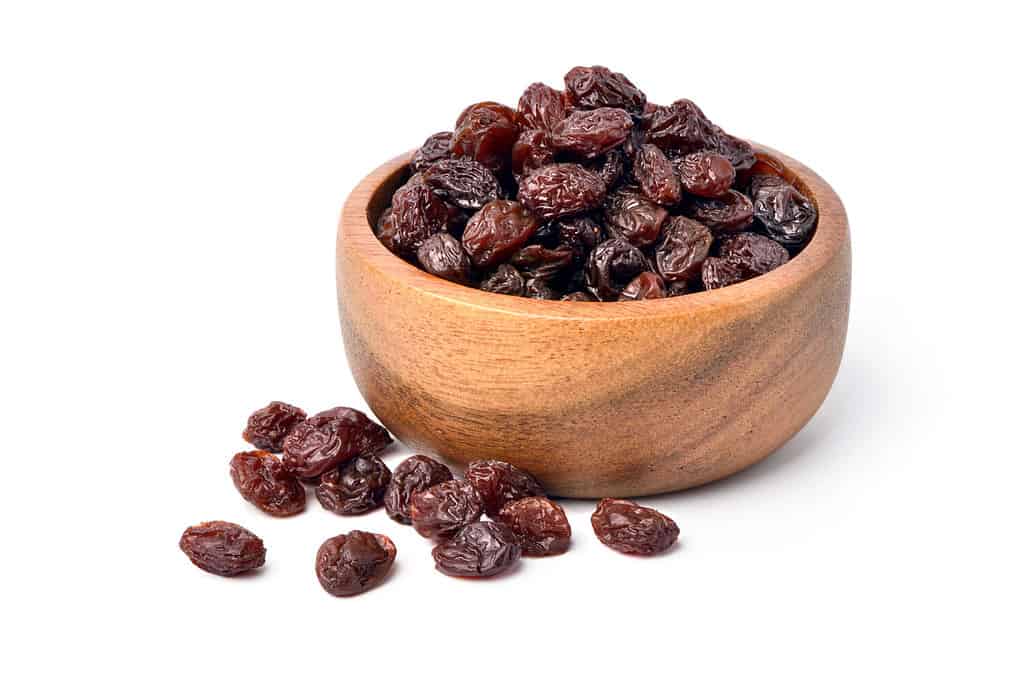
Aside from wine, grapes are also used for raisins, table grapes, and juice.
©Photoongraphy/Shutterstock.com
Grapes grown for consumption as table grapes, raisins, or grape juice are selected for factors like sweetness, texture, and appearance. These grapes prioritize immediate consumption, with attributes such as crispness and sweetness being highly valued. Unlike wine grapes, table grapes are typically harvested at an earlier stage of ripeness to maintain their firmness and visual appeal. The optimal growing conditions for table grapes may differ, with some varieties thriving in warmer climates where sugars can develop quickly, while others are suited for cooler regions where they can maintain their crispness. The growing period for table grapes can vary depending on the specific variety and purpose, but it generally aligns with the warmer months when the grapes can achieve the desired sweetness and texture.
Peak Grape Growing Season
California
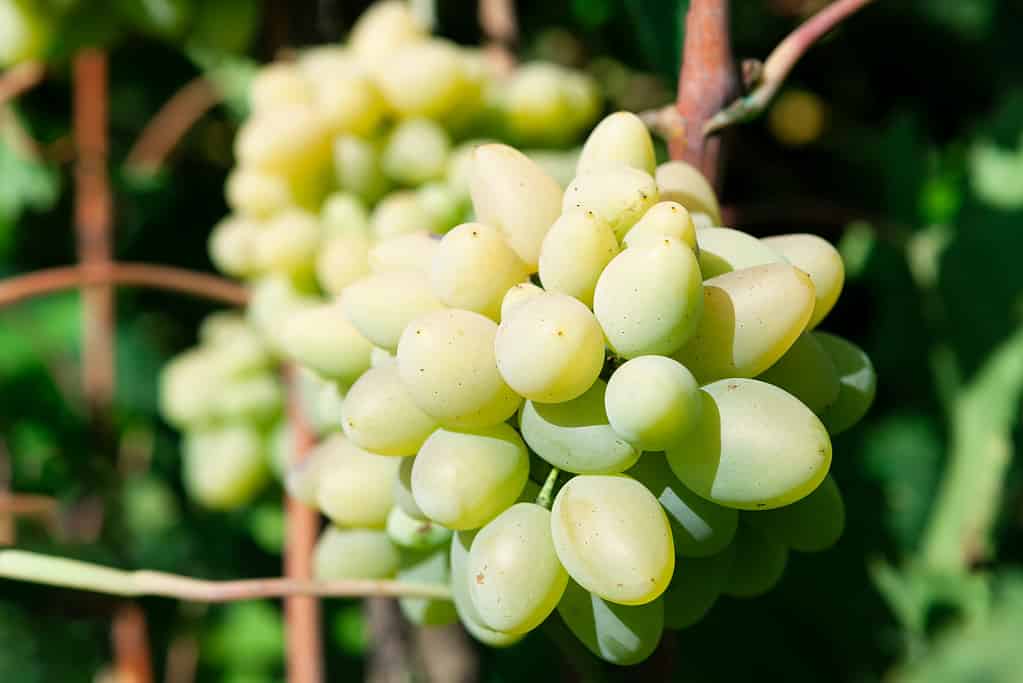
These “cotton candy” grapes growing in California are bred to accentuate their sweet taste.
©RussieseO/ via Getty Images
In California, grapes are in peak season between August and October although there is variation depending on the specific variety of grape. Several environmental variables make this the best season for growing and harvesting grapes.
- California has a Mediterranean climate with warm, dry summers and mild winters. These conditions suit grape cultivation because the warm temperature allows grapes to ripen fully and develop desirable flavors and sugars.
- Another important factor to consider is sunlight. As its name may suggest, the Golden State experiences a significant amount of sunlight. This is necessary for grapes to photosynthesize efficiently and ripen fully. California’s long daylight hours and ample sunshine ensure that grapes receive the energy they need to grow and mature.
- The diverse soil types across California’s wine regions offer a range of options for grape cultivation. Well-draining soils prevent waterlogging, which can harm grapevines. The soil composition also contributes to the complex flavors found in California wines.
- California’s wine regions are known for their microclimates—small-scale variations in climate within larger areas. These microclimates result from factors such as elevation, proximity to bodies of water, and geographical features. Growers can choose specific grape varieties that thrive in particular microclimates, allowing for a diverse range of wines.
- California boasts a wide array of grape varieties, each suited to different climatic conditions. Growers select grape varieties that are best adapted to the local climate, which contributes to the overall success of the grape growing season.
Washington
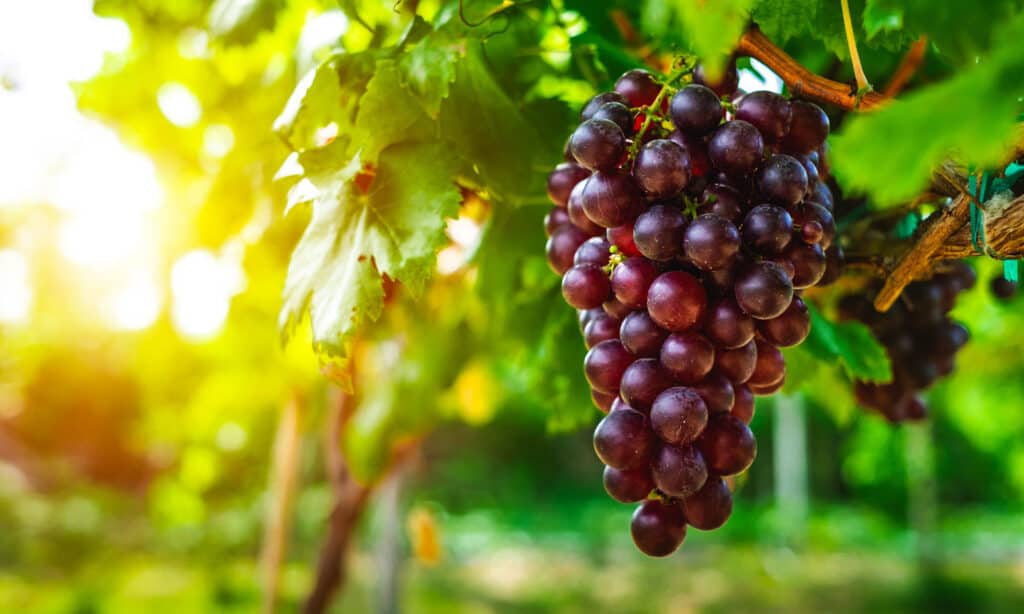
The second most grapes of all states in the United States are produced in Washington State.
©Ton Photographer 4289/Shutterstock.com
Washington State produces the second most grapes in the United States, primarily in eastern Washington. It accounts for 6% of the nation’s grape production, far less than California. The peak grape growing season in Washington typically spans from August to October. Depending on the kind of grape, harvest could continue into early November. During this period, a combination of favorable factors converges to create an optimal environment for grape cultivation in the state.
- Washington’s diverse climate, characterized by warm summers and crisp, cool nights, is particularly well-suited for grape cultivation. The significant diurnal temperature variation during the growing season helps grapes develop balanced sugars and acidity, enhancing the complexity of the resulting wines. While daytime temperatures are warm, Washington’s cool nights help slow down grape ripening, allowing flavors to develop more gradually. This extended ripening period contributes to the concentration of flavors and aromas in the grapes.
- Abundant sunlight is a crucial factor in grape maturation and flavor development. Eastern Washington’s sunny climate provides extensive sunlight hours during the growing season, promoting photosynthesis and healthy grapevine growth.
- Many vineyards in Washington have access to reliable water sources, often from rivers and irrigation systems originating from the Cascade Mountains. Controlled water availability allows growers to manage vine stress and tailor water delivery to specific growth stages.
- The state’s varied soil types, ranging from sandy to rocky to loamy, offer unique characteristics that influence grape development. Different soil compositions contribute to the diversity of flavors and styles found in Washington wines.
- Washington’s wine regions benefit from diverse geographical features, including river valleys, slopes, and elevations. These features create microclimates that influence grape growing conditions, allowing for the cultivation of many grape varieties.
New York
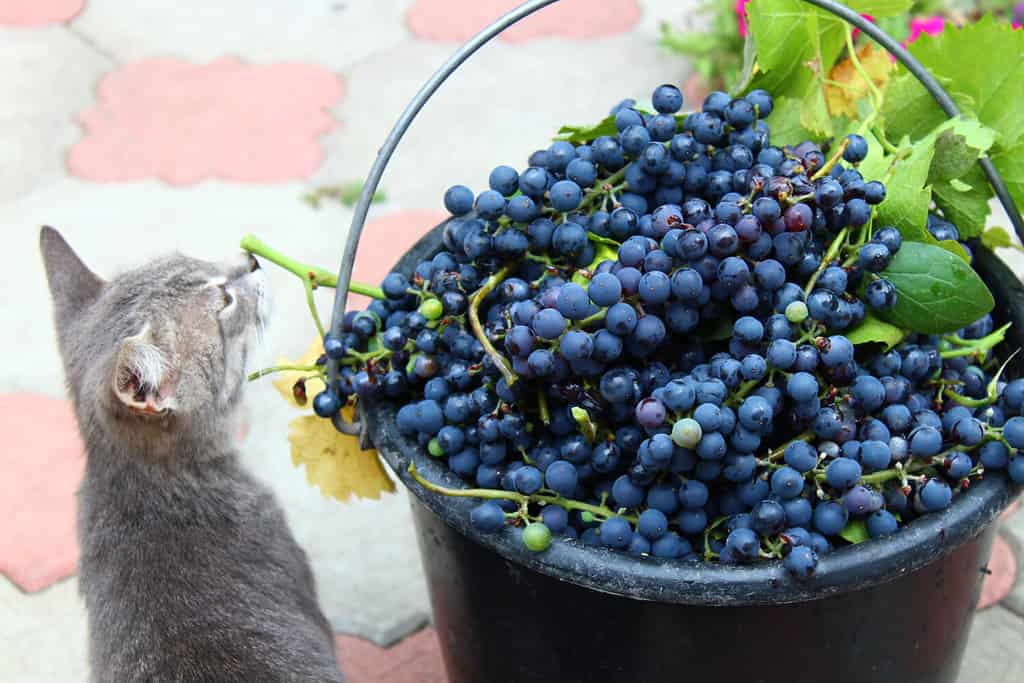
Grapes in New York flourish in varying climates in different regions across the state.
©DPaland/Shutterstock.com
The peak grape growing season in New York typically spans from August to October, as well. The season can begin as early as May and extend to early November depending on location and grape variety, however. In this time, several crucial factors create an ideal environment for grape cultivation in the state.
- New York’s climate varies across its wine regions, but its diverse weather patterns generally include warm summers and cooler nights. This combination of temperature fluctuations plays a significant role in fostering the development of flavors and aromas in the grapes.
- Ample sunlight is essential for photosynthesis, the process by which grapes convert light into energy. New York’s sufficient sunlight hours during the growing season ensure that the grapevines receive the energy they need to produce sugars and other compounds necessary for wine quality.
- Many New York vineyards are near water sources, such as the Finger Lakes, Lake Ontario, and the Hudson River. These bodies of water have a moderating effect on temperatures, protecting vines from extreme temperature shifts and frost events.
- New York’s diverse soil types, ranging from gravelly soils to clay loams, contribute to the unique characteristics of its wines. Different soils impact water retention, drainage, and nutrient availability, influencing the growth and development of grapevines.
- The state’s varied topography, including valleys, hills, and slopes, creates microclimates that suit different grape varieties. Vineyards situated on south-facing slopes receive optimal sunlight exposure, while those in valleys might benefit from better air circulation.
Oregon
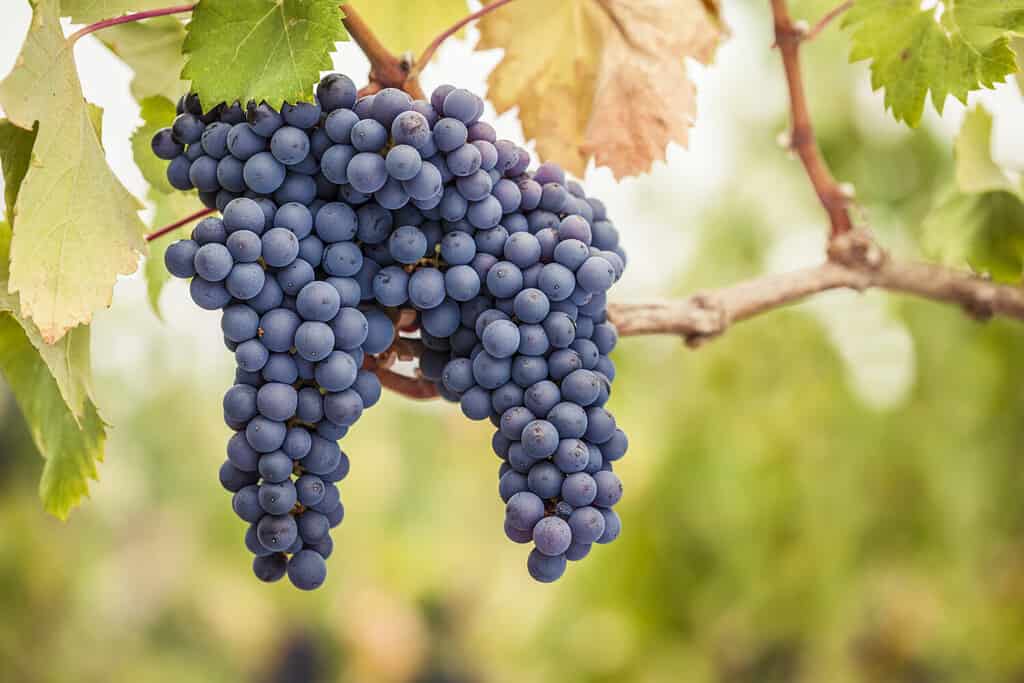
The most famous wine region in Oregon is the Willamette Valley.
©Andrew Hagen/Shutterstock.com
The peak grape growing season in Oregon typically spans from May to October. A combination of specific factors creates a favorable environment for grape production in the state.
- Oregon’s climate, which varies between its wine regions, generally features warm, dry summers and mild, wet winters. This climate is conducive to grape production, allowing for the slow and balanced ripening of grapes during the growing season.
- The state receives a considerable amount of sunlight during the grape growing season. Sunlight is crucial for photosynthesis, which provides the energy grapes need to develop sugars, flavors, and aromas.
- Similar to other successful wine regions, Oregon benefits from significant diurnal temperature variation. Warm days and cool nights help grapes retain acidity while developing complex flavors.
- While Oregon experiences rainfall during the growing season, careful water management practices are essential to prevent vine stress and disease. Regions like the Willamette Valley benefit from well-draining soils that reduce the risk of waterlogged roots.
- The state’s diverse soil types, including volcanic soils, sedimentary soils, and marine sediments, contribute to the unique character of Oregon wines. Different soils affect factors like drainage, mineral content, and nutrient availability for grapevines.
Texas
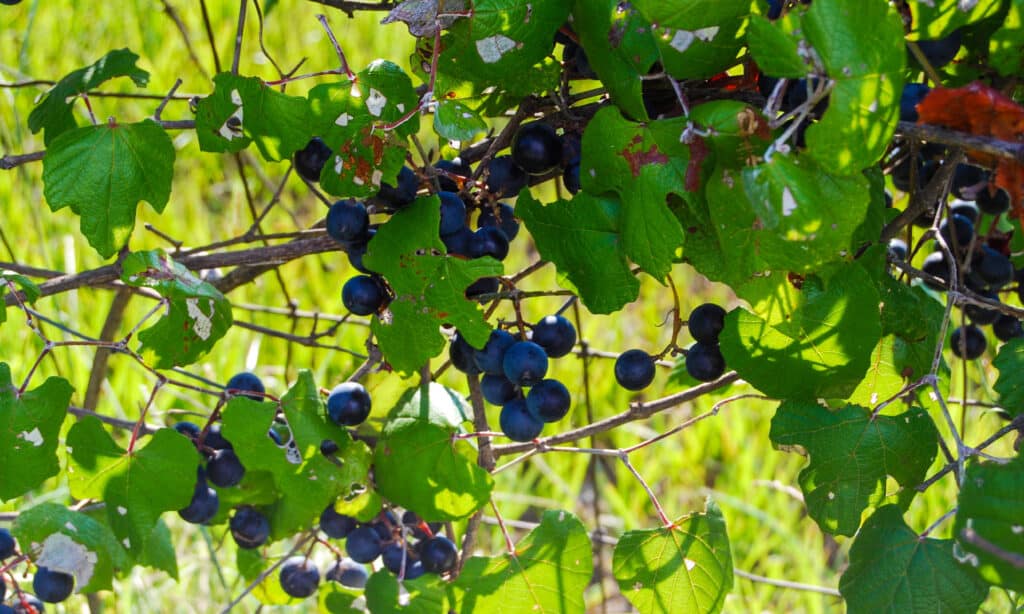
Mustang Grapes, Texas’ wild grapes, make exquisite homemade wine.
©CatherineTheGreat/Shutterstock.com
The peak grape growing season in Texas typically spans from July to October. Harvest of certain grape varieties occurs earlier or later than this period depending on conditions ideal to the specific grape. There are several elements that influence grape growing and harvest in Texas.
- Texas boasts a range of climates due to its vast size. Climates vary from arid conditions in the west to more humid environments in the east. This diversity allows for the cultivation of a wide variety of grape types, each suited to specific climatic zones.
- Texas receives a great amount of sunlight throughout the growing season, promoting photosynthesis and aiding grapevine growth and fruit development. The intense sunlight helps grapes accumulate sugars and develop their flavors.
- While Texas experiences hot summers, the significant diurnal temperature variation is particularly beneficial for grape cultivation. This variation helps grapes maintain acidity levels while allowing flavors to mature.
- The state’s diverse range of soil types, including limestone-rich soils, sandy loams, and volcanic soils, contributes to the unique character of Texas wines. Different soils influence drainage, nutrient availability, and the overall growth of grapevines.
- Texas’ varied topography, elevation changes, and proximity to water sources create microclimates that influence grape growing conditions. These microclimates allow for the cultivation of a variety of grape varieties that thrive in specific environments.
The photo featured at the top of this post is © Eric B Wolman/Shutterstock.com
Thank you for reading! Have some feedback for us? Contact the AZ Animals editorial team.







